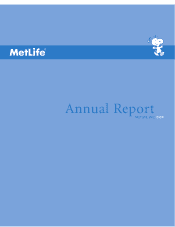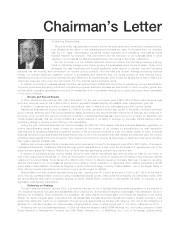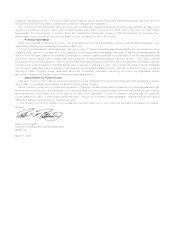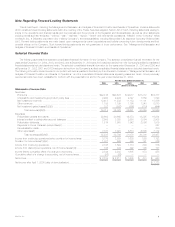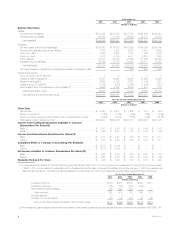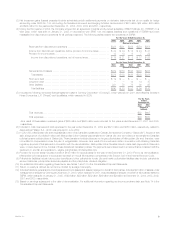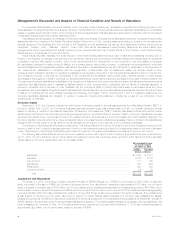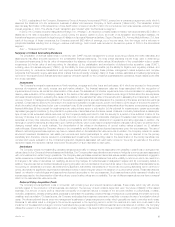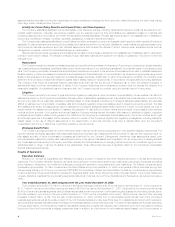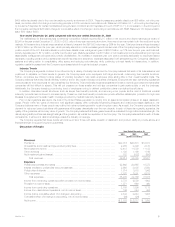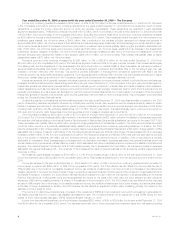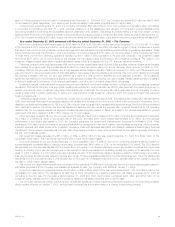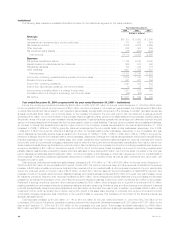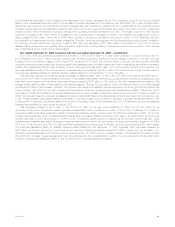MetLife 2004 Annual Report Download - page 7
Download and view the complete annual report
Please find page 7 of the 2004 MetLife annual report below. You can navigate through the pages in the report by either clicking on the pages listed below, or by using the keyword search tool below to find specific information within the annual report.
Management’s Discussion and Analysis of Financial Condition and Results of Operations
For purposes of this discussion, the terms ‘‘MetLife’’ or the ‘‘Company’’ refers to MetLife, Inc., a Delaware corporation (the ‘‘Holding Company’’), and
its subsidiaries, including Metropolitan Life Insurance Company (‘‘Metropolitan Life’’). Following this summary is a discussion addressing the consolidated
results of operations and financial condition of the Company for the periods indicated. This discussion should be read in conjunction with the Company’s
consolidated financial statements included elsewhere herein.
This Management’s Discussion and Analysis of Financial Condition and Results of Operations contains statements which constitute forward-looking
statements within the meaning of the Private Securities Litigation Reform Act of 1995, including statements relating to trends in the operations and
financial results and the business and the products of the Registrant and its subsidiaries, as well as other statements including words such as
‘‘anticipate,’’ ‘‘believe,’’ ‘‘plan,’’ ‘‘estimate,’’ ‘‘expect,’’ ‘‘intend’’ and other similar expressions. Forward-looking statements are made based upon
management’s current expectations and beliefs concerning future developments and their potential effects on the Company. Such forward-looking
statements are not guarantees of future performance.
Actual results may differ materially from those included in the forward-looking statements as a result of risks and uncertainties including, but not
limited to, the following: (i) changes in general economic conditions, including the performance of financial markets and interest rates; (ii) heightened
competition, including with respect to pricing, entry of new competitors and the development of new products by new and existing competitors;
(iii) unanticipated changes in industry trends; (iv) MetLife, Inc.’s primary reliance, as a holding company, on dividends from its subsidiaries to meet debt
payment obligations and the applicable regulatory restrictions on the ability of the subsidiaries to pay such dividends; (v) deterioration in the experience of
the ‘‘closed block’’ established in connection with the reorganization of Metropolitan Life; (vi) catastrophe losses; (vii) adverse results or other
consequences from litigation, arbitration or regulatory investigations; (viii) regulatory, accounting or tax changes that may affect the cost of, or demand for,
the Company’s products or services; (ix) downgrades in the Company’s and its affiliates’ claims paying ability, financial strength or credit ratings;
(x) changes in rating agency policies or practices; (xi) discrepancies between actual claims experience and assumptions used in setting prices for the
Company’s products and establishing the liabilities for the Company’s obligations for future policy benefits and claims; (xii) discrepancies between actual
experience and assumptions used in establishing liabilities related to other contingencies or obligations; (xiii) the effects of business disruption or
economic contraction due to terrorism or other hostilities; (xiv) the Company’s ability to identify and consummate on successful terms any future
acquisitions, and to successfully integrate acquired businesses with minimal disruption; and (xv) other risks and uncertainties described from time to time
in MetLife, Inc.’s filings with the United States Securities and Exchange Commission (‘‘SEC’’), including its S-1 and S-3 registration statements. The
Company specifically disclaims any obligation to update or revise any forward-looking statement, whether as a result of new information, future
developments or otherwise.
Economic Capital
Beginning in 2003, the Company changed its methodology of allocating capital to its business segments from Risk-Based Capital (‘‘RBC’’) to
Economic Capital. Prior to 2003, the Company’s business segments’ allocated equity was primarily based on RBC, an internally developed formula
based on applying a multiple to the National Association of Insurance Commissioners (‘‘NAIC’’) Statutory Risk-Based Capital and included certain
adjustments in accordance with accounting principles generally accepted in the United States of America (‘‘GAAP’’). Economic Capital is an internally
developed risk capital model, the purpose of which is to measure the risk in the business and to provide a basis upon which capital is deployed. The
Economic Capital model accounts for the unique and specific nature of the risks inherent in MetLife’s businesses. This is in contrast to the standardized
regulatory RBC formula, which is not as refined in its risk calculations with respect to the nuances of the Company’s businesses.
The change in methodology is being applied prospectively. This change has and will continue to impact the level of net investment income and net
income of each of the Company’s business segments. A portion of net investment income is credited to the segments based on the level of allocated
equity. This change in methodology of allocating equity does not impact the Company’s consolidated net investment income or net income.
The following table presents actual and pro forma net investment income with respect to the Company’s segments for the year ended Decem-
ber 31, 2002. The amounts shown as pro forma reflect net investment income that would have been reported in 2002 had the Company allocated
capital based on Economic Capital rather than on the basis of RBC.
Net Investment Income
For the Year Ended
December 31, 2002
Actual Pro forma
(Dollars in millions)
Institutional ********************************************************************************* $ 3,909 $ 3,971
Individual*********************************************************************************** 6,237 6,148
Auto & Home******************************************************************************* 177 160
International ******************************************************************************** 461 424
Reinsurance******************************************************************************** 421 382
Corporate & Other*************************************************************************** (22) 98
Total ********************************************************************************** $11,183 $11,183
Acquisitions and Dispositions
On January 31, 2005, the Holding Company completed the sale of SSRM Holdings, Inc. (‘‘SSRM’’) to a third party for $328 million of cash and
stock. As a result of the sale of SSRM, the Company recognized income from discontinued operations of approximately $150 million, net of income
taxes, comprised of a realized gain of $166 million, net of income taxes, and an operating expense related to a lease abandonment of $16 million, net of
income taxes. Under the terms of the agreement, MetLife will have an opportunity to receive, prior to the end of 2006, additional payments aggregating
up to approximately 25% of the base purchase price, based on, among other things, certain revenue retention and growth measures. The purchase price
is also subject to reduction over five years, depending on retention of certain MetLife-related business. The Company has reclassified the assets,
liabilities and operations of SSRM into discontinued operations for all periods presented in the consolidated financial statements. Additionally, the sale of
SSRM resulted in the elimination of the Company’s Asset Management segment. The remaining asset management business, which is insignificant, has
been reclassified into Corporate & Other. The Company’s discontinued operations for the year ended December 31, 2004 also includes expenses of
approximately $20 million, net of income taxes, related to the sale of SSRM.
MetLife, Inc.
4

